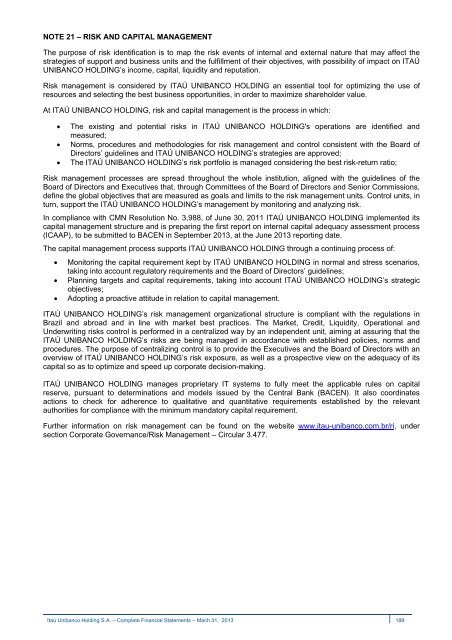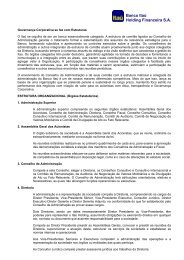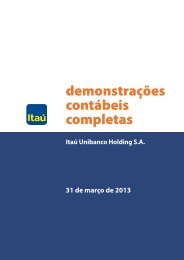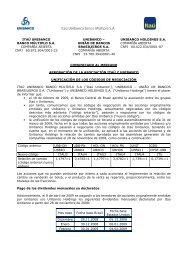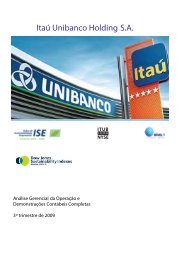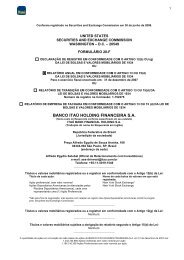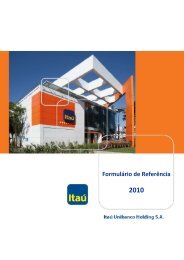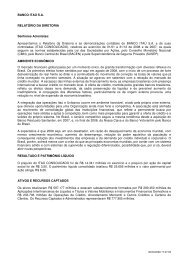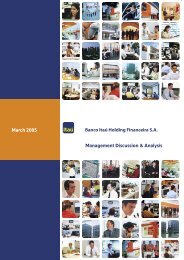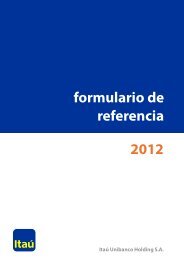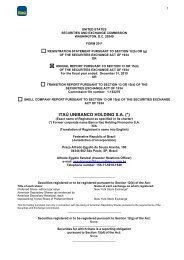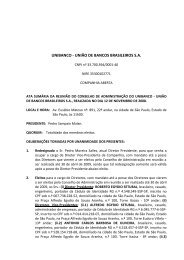NOTE 20 – INFORMATION ON FOREIGN SUBSIDIARIES Foreign branches (1) Latin America <strong>Itaú</strong> Europe Consolidated Other foreign companies Cayman Consolidated (4) Consolidated (2) (3) (5) Foreign consolidated (6) 03/31/2013 03/31/2012 03/31/2013 03/31/2012 03/31/2013 03/31/2012 03/31/2013 03/31/2012 03/31/2013 03/31/2012 03/31/2013 03/31/2012 Assets Current assets and long-term receivables Cash and cash equivalents 2,951,794 2,933,286 2,500,507 1,942,506 354,963 249,965 706,209 3,614,685 1,183,794 809,651 7,075,247 4,660,597 Interbank investments 8,903,151 11,994,110 2,733,319 1,199,270 2,444,944 2,108,217 7,724,290 7,512,931 214,006 782,852 11,790,299 13,657,554 Securities 54,975,384 43,897,650 4,147,825 3,800,337 2,051,080 1,584,526 5,397,770 4,729,889 29,298 28,226 65,977,332 53,502,277 Loan, lease and other credit operations 40,013,475 33,359,462 27,733,870 19,888,071 7,296,724 7,234,472 96,393 300,830 1,697 699 75,081,431 60,697,863 Foreign exchange portfolio 35,776,276 40,902,149 696,260 444,196 4,344,711 2,311,307 1,195,493 392,341 - - 37,817,296 43,689,875 Other assets 2,063,805 1,416,134 3,669,109 2,918,422 370,037 301,440 1,233,261 1,096,549 349,806 226,029 7,528,504 5,857,420 Permanent assets Investments 14,161 21,354 5,317 4,548 5,002 114,069 55,134 44,526 441,965 119,608 80,416 259,581 BPI - - - - - 110,347 - - - 114,850 - 225,196 Other investments 14,161 21,354 5,317 4,548 5,002 3,722 55,134 44,526 441,965 4,758 80,416 34,385 Fixed and intangible assets 21,174 26,452 561,210 482,096 161,837 167,513 828 1,607 18,279 16,085 710,612 693,754 Total 144,719,220 134,550,597 42,047,417 30,679,446 17,029,298 14,071,509 16,409,378 17,693,358 2,238,845 1,983,150 206,061,137 183,018,921 LIABILITIES Current and long-term liabilities Deposits 34,886,829 43,520,145 27,418,983 21,233,520 6,262,871 5,399,083 1,275,642 2,789,477 - - 62,209,879 60,245,191 Demand deposits 6,480,307 8,354,361 7,841,254 5,628,323 3,371,358 2,531,220 511,342 1,138,701 - - 17,582,240 12,730,983 Savings deposits - - 3,959,215 3,133,182 - - - - - - 3,959,215 3,133,182 Interbank deposits 10,914,950 10,147,846 106,611 172,631 1,391,077 1,211,931 764,300 - - - 7,212,349 10,888,741 Time deposits 17,491,572 25,017,938 15,511,903 12,299,384 1,500,436 1,655,932 - 1,650,776 - - 33,456,075 33,492,285 Deposits received under securities repurchase agreements 19,186,422 10,039,212 492,389 171,082 - - 2,918,007 1,691,728 - - 19,162,049 9,730,950 Funds from acceptance and issuance of securities 6,185,064 2,547,595 2,692,285 1,526,962 3,661,630 3,435,239 2,233,981 2,705,121 - - 14,749,883 10,190,414 Borrowings 19,938,766 13,532,719 2,632,201 1,755,292 368 559,930 9,972 9,768 2,473 30,998 22,583,779 15,857,709 Derivative financial instruments 1,697,806 1,250,676 245,937 202,235 474,671 539,240 514,730 602,823 - - 2,549,884 2,113,493 Foreign exchange portfolio 35,788,014 40,998,113 685,853 443,933 4,248,110 2,311,596 1,219,858 391,443 - - 37,746,391 43,784,966 Other liabilities 17,493,261 10,219,764 2,545,149 2,101,553 419,396 473,061 1,238,768 2,505,609 339,461 176,634 21,817,802 15,327,205 Deferred income 77,521 54,060 1,964 9,566 15,600 22,031 - 63 1,210 3,070 96,296 88,789 Minority interest in subsidiaries - - 8,869 8,571 64 61 791,718 716,294 - 3 792,041 716,553 Stockholders’ equity Capital and reserves 9,264,422 12,015,100 5,182,521 3,093,840 1,834,410 1,365,821 6,205,438 6,278,728 1,899,480 1,797,625 23,923,549 24,514,564 Net income for the period 201,115 373,213 141,266 132,892 112,178 (34,553) 1,264 2,304 (3,779) (25,180) 429,584 449,087 Total 144,719,220 134,550,597 42,047,417 30,679,446 17,029,298 14,071,509 16,409,378 17,693,358 2,238,845 1,983,150 206,061,137 183,018,921 Statement of Income Income from financial operations 759,670 1,036,221 754,062 595,353 180,841 58,318 13,152 73,625 (5,253) 7,456 1,641,740 1,719,632 Expenses of financial operations (440,543) (651,680) (294,410) (244,301) (26,946) (31,493) 8,616 (45,431) (36) (188) (704,761) (916,288) Result of loan losses (95,281) (8,351) (79,623) (12,644) 796 143 - - 1,128 (17) (172,979) (20,870) Gross income from financial operations 223,846 376,190 380,029 338,408 154,691 26,968 21,768 28,194 (4,161) 7,251 764,000 782,474 Other operating revenues (expenses) (22,731) (2,929) (177,823) (168,372) (28,544) (53,297) (20,504) (25,890) 6,679 (21,726) (252,968) (277,203) Operating income 201,115 373,261 202,206 170,036 126,147 (26,329) 1,264 2,304 2,518 (14,475) 511,032 505,271 Non-operating income - (48) 1,102 31 (3,532) 93 - - 407 371 (2,453) 300 Income before taxes on income and profit sharing 201,115 373,213 203,308 170,067 122,615 (26,236) 1,264 2,304 2,925 (14,104) 508,579 505,571 Income tax - - (53,905) (37,041) (8,737) (6,596) - - (6,704) (11,076) (69,347) (54,713) Statutory participation in income - - (7,936) (42) (1,699) (1,722) - - - - (9,635) (1,763) Minority interest in subsidiaries - - (201) (92) (1) 1 - - - - (13) (8) Net income (loss) 201,115 373,213 141,266 132,892 112,178 (34,553) 1,264 2,304 (3,779) (25,180) 429,584 449,087 (1) <strong>Itaú</strong> Unibanco S.A. - Branches Grand Cayman, New York and Tokyo, ITAÚ UNIBANCO HOLDING S.A - Branch Grand Cayman, <strong>Banco</strong> <strong>Itaú</strong>-BBA S.A - Nassau Branch; only at 03/31/2012, Unibanco Branch Grand Cayman and <strong>Itaú</strong> Unibanco S.A. - Nassau Branch. (2) <strong>Banco</strong> <strong>Itaú</strong> Argentina S.A, <strong>Itaú</strong> Asset Management S.A.Sociedad Gerente de Fondos Comunes de Inversión, Itrust Servicios Inmobiliarios S.A.C.I, <strong>Itaú</strong> Sociedad de Bolsa S.A., <strong>Itaú</strong> Chile Holdings Inc., BICSA Holdings LTD., <strong>Banco</strong> <strong>Itaú</strong> Chile S.A., <strong>Itaú</strong> Chile Inversiones, Servicios Y Administración S.A., <strong>Itaú</strong> Chile Corredor de Bolsa Ltda., <strong>Itaú</strong> Chile Corredora de Seguros Ltda., <strong>Itaú</strong> Chile Administradora General de Fondos S.A., Recuperadora de Créditos Ltda, <strong>Itaú</strong> Chile Compañia de Seguros de Vida S.A., ACO Ltda., <strong>Banco</strong> <strong>Itaú</strong> Uruguay S.A., OCA Casa Financiera S.A., OCA S.A., Unión Capital AFAP S.A., <strong>Banco</strong> Itau Paraguay, Tarjetas Unisoluciones S. A. de Capital Variable, Proserv - Promociones Y Servicios S.A. de C. V ., MCC Asesorias Limitada (50%), MCC Securites INC. (50%) and <strong>Itaú</strong> BBA SAS; only at 03/31/2012, EF Securitizadora S.A.; only at 03/31/2013, <strong>Itaú</strong> BBA Colômbia and MCC Corredora de Bolsa (50,0489%). (3) (4) (5) IPI - <strong>Itaú</strong>sa Portugal Investimentos, SGPS Lda. (49%), <strong>Itaú</strong>sa Europa - Investimentos, SGPS, Lda., <strong>Itaú</strong> Europa, SGPS, Lda., <strong>Itaú</strong>sa Portugal - SGPS S.A.,Itau BBA International (Cayman) Ltd., <strong>Banco</strong> <strong>Itaú</strong> Europa Luxembourg S.A., BIE Cayman Ltd., <strong>Banco</strong> <strong>Itaú</strong> Europa International, <strong>Itaú</strong> Bank & Trust Bahamas Ltd., <strong>Itaú</strong> Europa Securities Inc., <strong>Itaú</strong> Bahamas Directors Ltd., <strong>Itaú</strong> Bahamas Nominees Ltd., <strong>Banco</strong> Itau Suisse S.A. and <strong>Itaú</strong> BBA International Limited; only at 03/31/2012, BIE Directors Ltd, BIE Nominees Lda and <strong>Banco</strong> Itau BBA International S.A . Itau Bank Ltd., ITB Holding Ltd., Jasper International Investiment LLC, <strong>Itaú</strong> Bank & Trust Cayman Ltd., Uni-Investments Inter. Corp., Rosefield Finance Ltd. (50%), UBT Finance S.A., <strong>Itaú</strong> Cayman Directors Ltd. and <strong>Itaú</strong> Cayman Nominees Ltd.; only at 03/31/2012, Unibanco Cayman Bank Ltd. and Unipart Partic. Internac. Ltd. Afinco Americas Madeira, SGPS Soc. Unipessoal Ltda, Topaz Holding Ltd., <strong>Itaú</strong> USA Inc., <strong>Itaú</strong> International Investment LLC, Albarus S.A., <strong>Banco</strong> Del Paraná S.A., Garnet Corporation, Itau Global Asset Management, Mundostar S.A., Karen International Ltd., Nevada Woods S.A., <strong>Itaú</strong> Asia Securities Ltd., IPI - <strong>Itaú</strong>sa Portugal Investimentos, SGPS Lda. (51%), <strong>Itaú</strong> BBA USA Securities Inc., <strong>Itaú</strong> Middle East Limited, Unipart B2B Investments, S.L., Itau BBA UK Securities Limited, <strong>Itaú</strong> Japan Asset Management Ltd., <strong>Itaú</strong> (Beijing) Investment Consultancy Limited, <strong>Itaú</strong> UK Asset Management Limited, <strong>Itaú</strong> Asia Asset Management Limited and Itau USA Asset Management; only at 03/31/2012, Zux Cayman Company Ltd. and Líbero Trading International Ltd. (6) Foreign consolidated information presents balances net of eliminations from consolidation. <strong>Itaú</strong> Unibanco Holding S.A. – Complete Financial Statements – Mach 31, 2013 188
NOTE 21 – RISK AND CAPITAL MANAGEMENT The purpose of risk identification is to map the risk events of internal and external nature that may affect the strategies of support and business units and the fulfillment of their objectives, with possibility of impact on ITAÚ UNIBANCO HOLDING’s income, capital, liquidity and reputation. Risk management is considered by ITAÚ UNIBANCO HOLDING an essential tool for optimizing the use of resources and selecting the best business opportunities, in order to maximize shareholder value. At ITAÚ UNIBANCO HOLDING, risk and capital management is the process in which: The existing and potential risks in ITAÚ UNIBANCO HOLDING's operations are identified and measured; Norms, procedures and methodologies for risk management and control consistent with the Board of Directors’ guidelines and ITAÚ UNIBANCO HOLDING’s strategies are approved; The ITAÚ UNIBANCO HOLDING’s risk portfolio is managed considering the best risk-return ratio; Risk management processes are spread throughout the whole institution, aligned with the guidelines of the Board of Directors and Executives that, through Committees of the Board of Directors and Senior Commissions, define the global objectives that are measured as goals and limits to the risk management units. Control units, in turn, support the ITAÚ UNIBANCO HOLDING’s management by monitoring and analyzing risk. In compliance with CMN Resolution No. 3,988, of June 30, 2011 ITAÚ UNIBANCO HOLDING implemented its capital management structure and is preparing the first report on internal capital adequacy assessment process (ICAAP), to be submitted to BACEN in September 2013, at the June 2013 reporting date. The capital management process supports ITAÚ UNIBANCO HOLDING through a continuing process of: Monitoring the capital requirement kept by ITAÚ UNIBANCO HOLDING in normal and stress scenarios, taking into account regulatory requirements and the Board of Directors’ guidelines; Planning targets and capital requirements, taking into account ITAÚ UNIBANCO HOLDING’s strategic objectives; Adopting a proactive attitude in relation to capital management. ITAÚ UNIBANCO HOLDING’s risk management organizational structure is compliant with the regulations in Brazil and abroad and in line with market best practices. The Market, Credit, Liquidity, Operational and Underwriting risks control is performed in a centralized way by an independent unit, aiming at assuring that the ITAÚ UNIBANCO HOLDING’s risks are being managed in accordance with established policies, norms and procedures. The purpose of centralizing control is to provide the Executives and the Board of Directors with an overview of ITAÚ UNIBANCO HOLDING’s risk exposure, as well as a prospective view on the adequacy of its capital so as to optimize and speed up corporate decision-making. ITAÚ UNIBANCO HOLDING manages proprietary IT systems to fully meet the applicable rules on capital reserve, pursuant to determinations and models issued by the Central Bank (BACEN). It also coordinates actions to check for adherence to qualitative and quantitative requirements established by the relevant authorities for compliance with the minimum mandatory capital requirement. Further information on risk management can be found on the website www.itau-unibanco.com.br/ri, under section Corporate Governance/Risk Management – Circular 3.477. <strong>Itaú</strong> Unibanco Holding S.A. – Complete Financial Statements – Mach 31, 2013 189
- Page 1 and 2:
financial report March 31, 2013 Ita
- Page 3 and 4:
management discussion analysis Ita
- Page 5 and 6:
Executive Summary Information and f
- Page 7 and 8:
Executive Summary Effects of the Re
- Page 9 and 10:
Executive Summary We present below
- Page 11 and 12:
Executive Summary Banking Services
- Page 13 and 14:
Executive Summary Credit Portfolio
- Page 15 and 16:
analysis of net income Itaú Uniban
- Page 17 and 18:
Analysis of Net Income Managerial F
- Page 19 and 20:
Analysis of Net Income Banking Serv
- Page 21 and 22:
Analysis of Net Income Result from
- Page 23 and 24:
Analysis of Net Income Non-interest
- Page 25 and 26:
Analysis of Net Income Points of Se
- Page 27 and 28:
alance sheet, balance sheet by curr
- Page 29 and 30:
Balance Sheet Short-term Interbank
- Page 31 and 32:
Balance Sheet Funding Mar 31, 13 De
- Page 33 and 34:
Balance Sheet by Currency We adopt
- Page 35 and 36:
Capital Ratios (BIS) Solvency Ratio
- Page 37 and 38:
Ownership Structure The management
- Page 39 and 40:
Annual and Extraordinary Stockholde
- Page 41 and 42:
analysis of segments, products and
- Page 43 and 44:
Analysis of Segments Pro Forma Adju
- Page 45 and 46:
Analysis of Segments The pro forma
- Page 47 and 48:
Analysis of Segments Wholesale Bank
- Page 49 and 50:
Products and Services Cards Through
- Page 51 and 52:
anking operations & insurance opera
- Page 53 and 54:
Banking Operations & Insurance Oper
- Page 55 and 56:
Insurance, Life and Pension Plan &
- Page 57 and 58:
Insurance The figures presented in
- Page 59 and 60:
Life and Pension Plan Pro Forma Rec
- Page 61 and 62:
activities abroad Itaú Unibanco Ho
- Page 63 and 64:
Activities abroad Main Operations i
- Page 65 and 66:
Activities abroad Latin America - B
- Page 67 and 68:
Activities abroad Itaú BBA Interna
- Page 70 and 71:
(This page was left in blank intent
- Page 72 and 73:
Itaú Unibanco Holding S.A. - Compl
- Page 74 and 75:
Banco Itaú BMG Consignado S.A. - i
- Page 76 and 77:
3.2) Income R$ billion Statement of
- Page 78 and 79:
Default At March 31, 2013, total de
- Page 80 and 81:
Custody Services - In the custody m
- Page 82 and 83:
In the January-March 2013 period, t
- Page 84 and 85:
ITAÚ UNIBANCO S.A. Chief Executive
- Page 86 and 87:
ITAÚ UNIBANCO HOLDING S.A. Consoli
- Page 88 and 89:
ITAÚ UNIBANCO HOLDING S.A. Consoli
- Page 90 and 91:
ITAÚ UNIBANCO HOLDING S.A. Consoli
- Page 92 and 93:
ITAÚ UNIBANCO HOLDING S.A. Stateme
- Page 94 and 95:
Itaú Unibanco Holding S.A. Stateme
- Page 96 and 97:
ITAÚ UNIBANCO HOLDING S.A. NOTES T
- Page 98 and 99:
In ITAÚ UNIBANCO HOLDING CONSOLIDA
- Page 100 and 101:
NOTE 3 - REQUIREMENTS OF CAPITAL AN
- Page 102 and 103:
During this period, the effects of
- Page 104 and 105:
Cash Flow Hedge - the effective amo
- Page 106 and 107:
Mathematical provisions for benefit
- Page 108 and 109:
NOTE 5 - CASH AND CASH EQUIVALENTS
- Page 110 and 111:
NOTE 7 - SECURITIES AND DERIVATIVE
- Page 112 and 113:
c) Trading securities See below the
- Page 114 and 115:
e) Held-to-maturity securities See
- Page 116 and 117:
I - Derivatives by index Memorandum
- Page 118 and 119:
II - Derivatives by counterparty Se
- Page 120 and 121:
III - Derivatives by notional amoun
- Page 122 and 123:
V - Accounting hedge a) The effecti
- Page 124 and 125:
VI - Realized and unrealized gain o
- Page 126 and 127:
j) Sensitivity analysis (TRADING AN
- Page 128 and 129:
II - By maturity and risk level 03/
- Page 130 and 131:
) Credit concentration Loan, lease
- Page 132 and 133:
e) Restricted operations on assets
- Page 134 and 135:
NOTE 9 - FOREIGN EXCHANGE PORTFOLIO
- Page 136 and 137:
c) Deposits received under securiti
- Page 138 and 139: e) Borrowings and onlending BORROWI
- Page 140 and 141: Description Name of security / Curr
- Page 142 and 143: ) Assets Guaranteeing Technical Pro
- Page 144 and 145: NOTE 12 - CONTINGENT ASSETS AND LIA
- Page 146 and 147: - Tax and social security lawsuits
- Page 148 and 149: The main discussions related to Leg
- Page 150 and 151: c) Receivables - Reimbursement of c
- Page 152 and 153: ) Prepaid expenses Commissions 03/3
- Page 154 and 155: d) Banking service fees 01/01 to 03
- Page 156 and 157: f) Personnel expenses Compensation
- Page 158 and 159: NOTE 14 - TAXES a) Composition of e
- Page 160 and 161: ) Deferred taxes I - The deferred t
- Page 162 and 163: III - The estimate of realization a
- Page 164 and 165: d) Taxes paid or provided for and w
- Page 166 and 167: II - Composition of investments 03/
- Page 168 and 169: II) Goodwill CHANGES Amortization p
- Page 170 and 171: NOTE 16 - STOCKHOLDERS’ EQUITY a)
- Page 172 and 173: c) Capital and revenue reserves 03/
- Page 174 and 175: f) Stock Option Plan I - Purpose an
- Page 176 and 177: Summary of Changes in the Share-Bas
- Page 178 and 179: NOTE 17 - RELATED PARTIES a) Transa
- Page 180 and 181: ) Compensation of Management Key Pe
- Page 182 and 183: To obtain the market values for the
- Page 184 and 185: c) Defined benefit plan I - Main as
- Page 186 and 187: V- Change in the net amount recogni
- Page 190 and 191: I - Market Risk Market risk is the
- Page 192 and 193: II - Credit Risk Credit risk is the
- Page 194 and 195: NOTE 22 -SUPPLEMENTARY INFORMATION
- Page 196 and 197: Report on Review To the Directors a
- Page 198: ITAÚ UNIBANCO HOLDING S.A. CNPJ. 6


